Labor Encumbrance Process
Definition
The purpose of this appendix is to provide an understanding of the Labor Encumbrance process in Labor Distribution. A process flow diagram shows the interaction between the different components in Labor Distribution. Each process is briefly explained and chapter references are provided for more information. Also included in this chapter is a description of rules governing the creation and update of encumbrances, including various scenarios pertaining to these processes.
Labor Encumbrance Process Flow Diagram
Figure 1 shows the Labor Encumbrance Process Flow diagram as described in the accompanying text.
Labor Encumbrance Process Flow Diagram
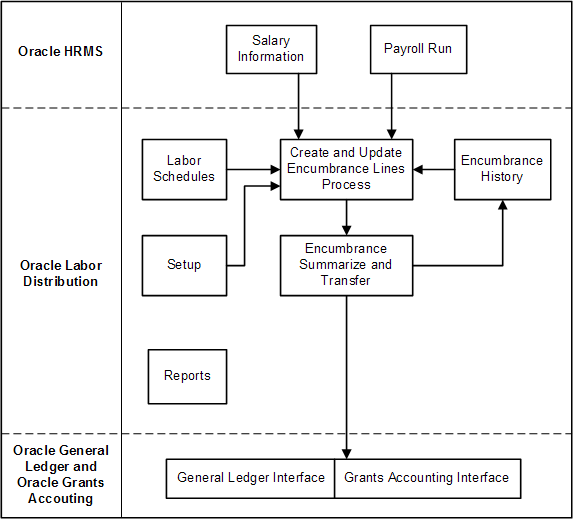
Labor Encumbrance Process
This section describes the Labor Encumbrance process flow diagram.
The Labor Encumbrance process includes the following components:
Setup
Labor Encumbrance setup provides users with the ability to customize predefined components through configuration options. These options delivered with Labor Distribution alleviate the need for software code modifications.
For information on Labor Encumbrance setup, see Labor Encumbrance Setup.
Labor Scheduling
Labor scheduling is an online process used to create, update, and review employee labor schedules. The labor schedules are a required input for the Create Encumbrance Lines process.
For information on labor scheduling, see Labor Scheduling Procedures.
Create and Update Encumbrance Lines
The PSP: Create and Update Encumbrance Lines process enables you to generate, update, and liquidate encumbrances for the elements that you selected when you set up labor encumbrances.
See: Processes.
Summarize and Transfer Encumbrances
Summarize and Transfer Encumbrances is a concurrent process that posts data to Oracle General Ledger and Oracle Grants Accounting. Setup options allow the user to group the data based on time period and charging instructions.
For information on summarizing and transferring encumbrances, see Labor Encumbrance Processes and Reports Procedures.
Encumbrance History
During the Summarize and Transfer Encumbrances process, an encumbrance history is stored in the tables to be used for the Create and Update Encumbrance Lines process.
Reports
Labor Encumbrance includes the following reports:
-
Suspense Charge Encumbrance Report
-
Organization Default Usage Encumbrance Report
-
Encumbrance History by Award Report
-
Encumbrance History by Organization Report
-
Assignments Processed by Create and Update Encumbrance Lines Report
See: Review Posted Encumbrance Reports.
Labor Encumbrance End Date Scenarios Diagram
This topic explains the labor encumbrance end date scenarios when you run the Create and Update Encumbrance Lines process.
See: Processes.

In the above example, the application creates encumbrances till 31-Oct, which is the award end date that you specified using the user hook.

In the above example, the award end date that you specified using the user hook extends beyond the encumbrance default end date. Therefore, the application creates encumbrances till the award end date (31-Oct).

In the above example, although the award encumbrance end date you specified using the user hook extends to 31-Oct-2006, the labor schedule ends on 31-Aug-2006. Therefore, the application creates encumbrances till 24-May, which is the default encumbrance end date of the labor schedule.
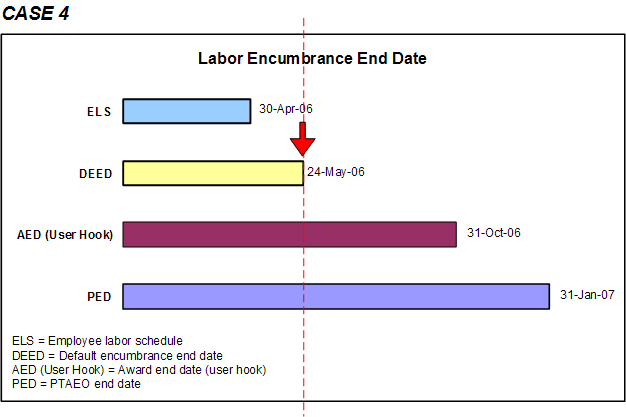
In the above example, because the employee labor schedule ends before the default encumbrance end date, the application encumbers till the end of the labor schedule, and then continues to encumber in the following order till the default encumbrance end date (24-May):
-
Organization default labor schedule, or
-
Organization default account, or
-
Suspense account
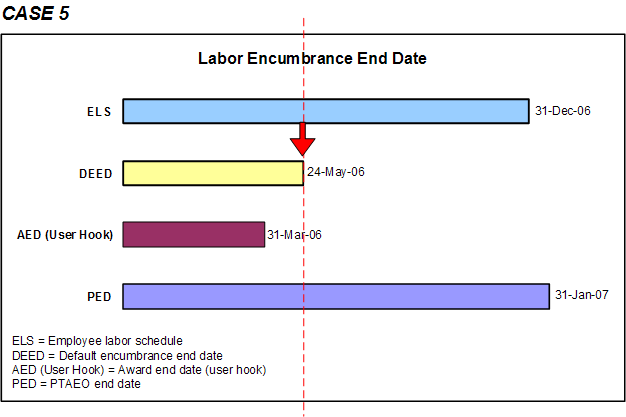
In the above example, the award end date you specified using the user hook ends earlier than the labor schedule. Therefore, the application encumbers till the labor schedule is valid (31-Mar-2006). The application posts encumbrances beyond 31-Mar to the suspense account till the default encumbrance end date (24-May).
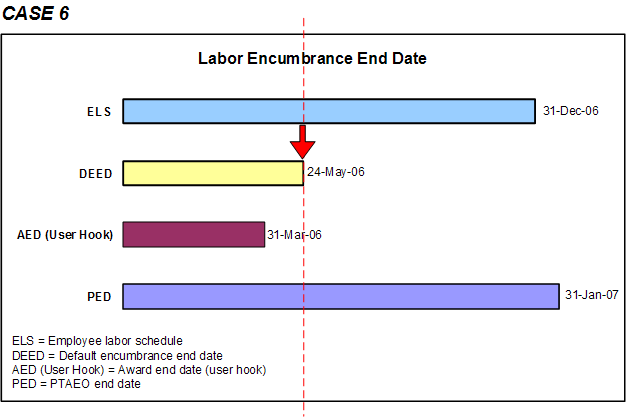
In the above example, the application encumbers till the award end date you specified using the user hook. The application posts encumbrances beyond 31-Mar to the suspense account till the default encumbrance end date (24-May).
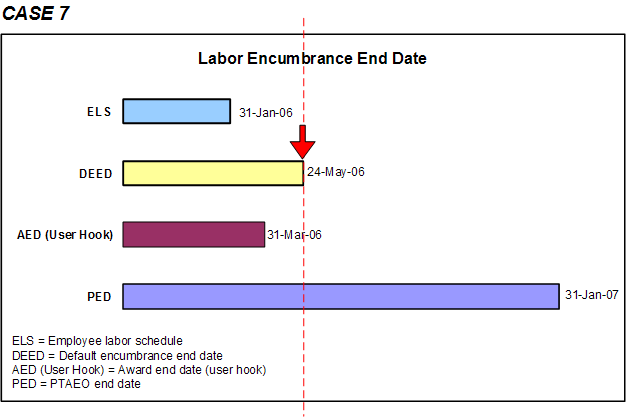
In the above example, the application encumbers funds till the end of the labor schedule and posts encumbrances beyond 31-Jan in the following order till the default encumbrance end date (24-May):
-
Organization default labor schedule, or
-
Organization default account, or
-
Suspense account

In the above example, the end date of the award that you specified using the user hook occurs earlier than the labor schedule (31-Mar-2006). Therefore, the application posts encumbrances from 01-Apr to 30-Apr to the suspense account, and from 1-May to 24-May, to the organization default labor schedule, or the organization default account, or the suspense account.
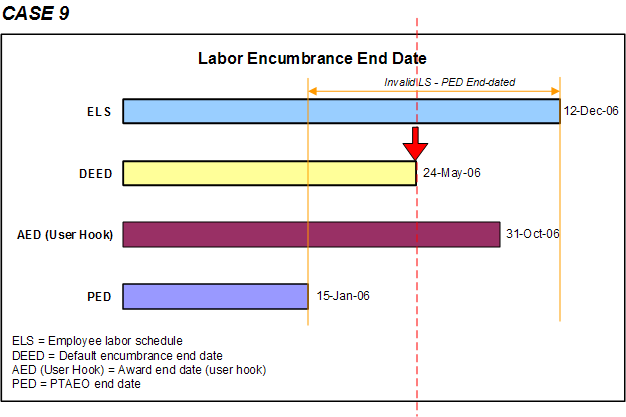
In the above example, the labor schedule is invalid as the PTAEO ends before the labor schedule's end date. Therefore, the application creates encumbrances till the end of the PED (PTAEO end date,) and posts encumbrances beyond 15-Jan the suspense account until the encumbrance default end date (24-May).

In the above example, the labor schedule after 15-Jan is invalid as the PTAEO ends before the labor schedule's end date. Therefore, the application creates encumbrances till the PED and posts encumbrances from 16-Jan to 30-Apr to the suspense account. The application posts encumbrances beyond 30-Apr to the organization default labor schedule, or the organization default account, or suspense account, till the default encumbrance end date (24-May).
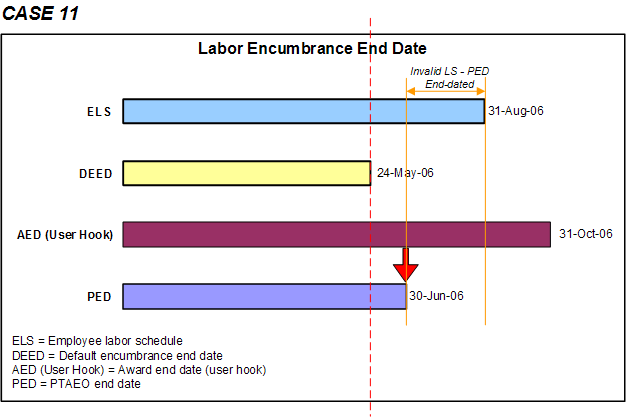
In the above example, the labor schedule after 30-Jun is invalid as the PED is before the labor schedule's end date (31-Aug). Therefore, the application creates encumbrances till PED (30-Jun)
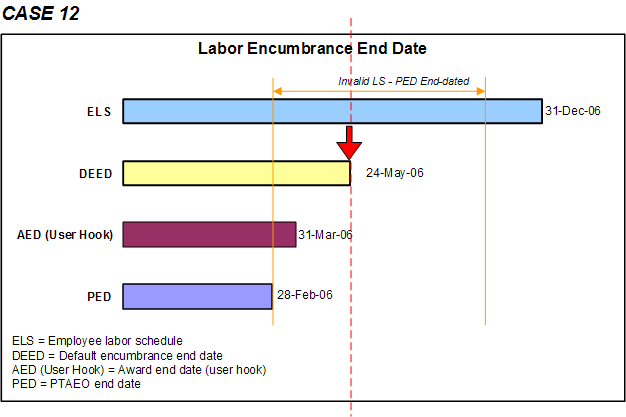
In the above example, the labor schedule after 28-Feb is invalid as the PED is before the labor schedule's end date. Therefore, the application creates encumbrances till the PED (28-Feb). The application posts encumbrances beyond 28-Feb to the suspense account till the default encumbrance end date (24-May).
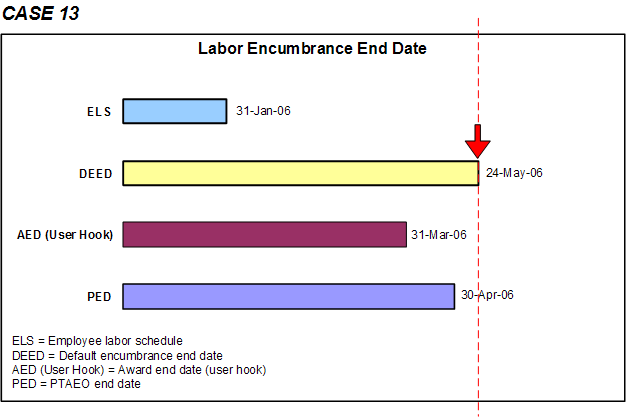
In the above example, the PED extends beyond the end date of the labor schedule. Therefore, the application creates encumbrances till the PED according to the labor schedule. The application continues to encumber till 24-May, which is the default encumbrance end date, and posts encumbrances to the organization default labor schedule, or the organization default account, or the suspense account.

In the above example, the labor schedule extends beyond the award end date you specified using the user hook. Therefore, the application encumbers till the award end date and posts encumbrances beyond 31-Mar to the suspense account till 30-Apr. The application then continues to encumber from 01-May till the default encumbrance end date (24-May) to the organization default labor schedule, or organization default account, or the suspense account.